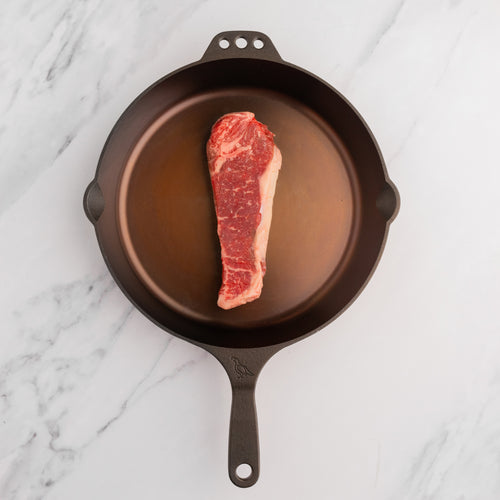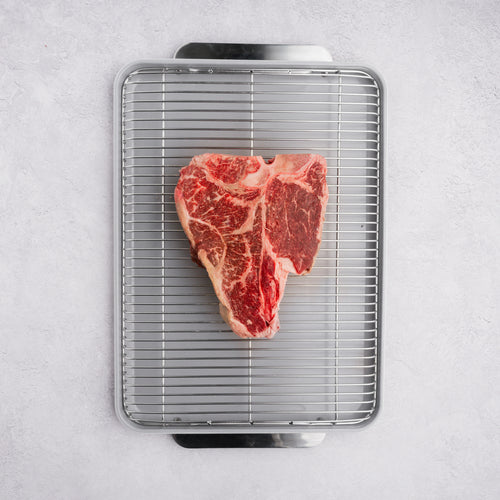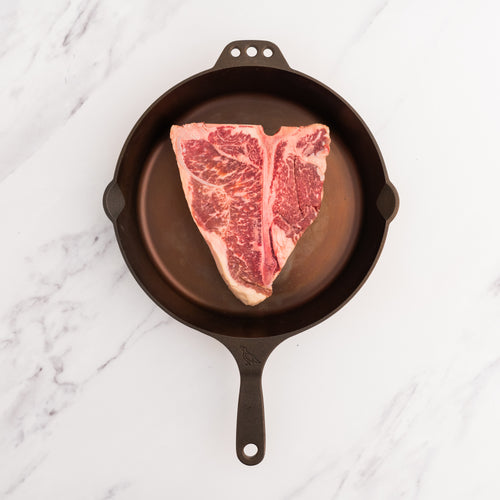
What is beef grading and why is it important?
You’ve likely seen USDA grade listed on meat labels at the supermarket. You may also have heard about meat-grading systems from other countries.
What is beef grading? Who devised these systems? And why should you care about beef grading?
At Snake River Farms, we’ve been pioneering a better beef experience for decades. If you care about serving your family the best possible meat, read our breakdown of beef grading systems to get insight on how they translate to your plate.

USDA Guidelines for Beef Grading
The United States Department of Agriculture (USDA) created grade standards for beef as a kind of shared language between the domestic beef industry and consumers. The USDA grade shield on steaks and other meat cuts indicates a level of safety and quality that is generally uniform.
The USDA uses a combination of subjective characteristics and electronic instrument data to place all U.S. beef into eight categories, although the top three grades are the ones most commonly available in stores and restaurants.
USDA beef grading placed quality American beef into three grades:
-
Prime – Abundant marbling from young, well-fed cattle, almost always sold to high-end restaurants, gourmet grocers and better butcher shops
-
Choice – Less marbling but still high-quality meat
- Select – Uniform in quality but leaner than higher grades and the most common grade found in grocery stores
The other USDA grades are rarely found displayed in stores and are reserved for canned food and other processed products.
Understanding beef grading is one thing—tasting the difference is another.
Discover our USDA Choice and Prime cuts and experience why quality grading matters.
Shop USDA Choice & Prime →

International Grades: Beef Marbling Score
All Snake River Farms beef grades equal or higher than USDA Prime. How do we manage to measure these national guidelines? We use a system called the Beef Marbling Score which measures marbling that exceeds USDA guideline.
Marbling refers to the amount of intramuscular fat interspersed among the muscle in any cut of meat which appears like striations on a piece of marble. This kind of fat enhances the flavor, tenderness and juiciness of meat. It’s different from intermuscular fat, which occurs between the muscles. Those white hunks of fat are generally trimmed away, as they do not add to the eating experience.
Japan and Australia have their own grading systems to measure intramuscular fat. Snake River Farms grades American Wagyu beef using a scale based on the Japanese Beef Marbling Score (BMS) with a range of 1-12. USDA Prime and SRF Silver® measure 4-5, SRF Black® scores 6-8, SRF Gold® measures 9-10 and SRF Gold Plus™ tops the scale at 11-12.
Learn more about the different marble scores for Wagyu→

Snake River Farms Grading: A Cut Above
All the beef at Snake River Farms falls into four categories that we’ve developed by synthesizing the USDA and BMS systems.
Our American Wagyu grades align with this scale as follows:
- SRF Silver® – BMS 4–5. Abundant marbling equivalent to USDA Prime.
- SRF Black® – BMS 6–8. Significantly more marbling than USDA Prime.
- SRF Gold® – BMS 9–10. Dramatically more marbling than USDA Prime.
- SRF Gold Plus™ – BMS 11–12. The highest marbling available from Snake River Farms.

American Wagyu Gold Plus
Experience the pinnacle of marbling and flavor. SRF Gold Plus™ delivers unmatched tenderness and richness, with every bite melting in your mouth. Graded at the highest level of the Beef Marbling Score (BMS 11–12), this is American Wagyu at its most indulgent.
Shop SRF Gold Plus™ →American Wagyu Beef
Discover the flavor that redefined American beef. Our signature American Wagyu combines the buttery texture and deep marbling of Japanese Wagyu with the robust character of American beef—crafted for chefs and home cooks who demand extraordinary quality.
Shop American Wagyu Beef →






